23
October 2020
PDF version [480KB]
Geoff
Gilfillan
Statistics and Mapping Section
Introduction
The restrictions imposed by Federal, State
and Territory Governments to limit the spread of COVID-19 have had different
labour market impacts across demographic groups, industries and regions.
This paper draws on the results of two Australian Bureau of
Statistics (ABS) data series that shed light on the extent of the impact of
COVID-19 on the Australian labour market. The two data series are the Weekly
Payroll Jobs and Wages in Australia series (which had its first release on
4 April 2020) and the long established Labour
Force survey. The Weekly Payroll Jobs and Wages series shows percentage
changes in jobs and wages for employees whereas the Labour Force series
captures change in the number of people that are employed, unemployed or
not in the labour force.
Contents
Introduction
Executive Summary
Impact on jobs and wages
Change in jobs and wages by age
Table 1: percentage change in jobs and
wages by age, 14 March to 3 October 2020
Change in jobs and wages by gender
Table 2: percentage change in jobs and
wages by gender, 14 March to 3 October 2020
Change in jobs by firm size
Table 3: percentage change in jobs and
wages by firm size, 14 March to 3 October 2020
Change in jobs and wages by industry
Table 4: percentage change in jobs and
wages by industry, 14 March to 3 October 2020
Change in jobs and wages by
state/territory
Table 5: percentage change in jobs and
wages by state/territory, 14 March to 3 October 2020
Change in jobs by region
Table 6: percentage change in payroll
jobs, 14 March to 3 October 2020
Impact on employment, unemployment,
participation and hours worked
Employment by age
Chart 1: change in employment by age,
March to September 2020
Unemployment by age
Chart 2: change in unemployment by
age, March to September 2020
Chart 3: change in unemployment rates
by age, March to September 2020
Labour market impacts by gender
Chart 4: change in key labour market
indicators by gender, March to September 2020
Table 7: change in full-time and
part-time employment by gender, March to September 2020
Hours worked by gender
Chart 5: hours worked by gender, March
to September 2020
Chart 6: percentage change in monthly
hours worked by gender, March to September 2020
Change in employment by state and
territory
Chart 7: change in employment by
state/territory, March to September 2020
Change in unemployment rates by state
and territory
Chart 8: unemployment rate by
state/territory, March to September 2020
Change in labour force participation
by state and territory
Chart 9: change in participation rates
for states and territories, May to September 2020
Impact on industries
Table 8: change in employment by
industry, February to August 2020
Impact on casual and permanent
employees and owner managers
Table 9: change in permanent and
casual employees, February to August 2020
Chart 10: change in employees and
owner managers, March to August 2020
Impact on numbers of people receiving
unemployment benefits
Table 10: JobSeeker Payment and Youth
Allowance (Other) recipients, March and August 2020
Executive
Summary
The various data sources available show since restrictions
were put in place to limit the spread of COVID-19 in March 2020:
- Job loss has been greatest in percentage terms in Accommodation
and food services and Arts and recreation services.
- People aged 20 to 29 years and those aged 60 years or more have
been impacted the most in terms of job loss.
- Workers aged 40 years and over have experienced greater loss of
wages.
- Employment loss and increases in unemployment has been greatest
for those aged 20 to 34 years.
- The outcomes are less clear for people aged under 20 years with
one data source showing growth in jobs and another source showing a decline in
employment.
- Men have been affected slightly more than women in terms of rate
of job loss and decline in numbers of employed, but much more affected in terms
of rate of wages loss and change in numbers of underemployed.
- Casual workers accounted for a significant share of the decline
in employees.
- Full-time workers have been affected far more in terms of
employment loss than part-time workers.
-
There has been little change in the number of business operators
but a substantial decrease in employees of private and public enterprises.
- Men and younger people experienced larger increases in unemployment
beneficiaries.
Impact on
jobs and wages
The ABS Weekly
Payroll Jobs and Wages in Australia series shows the change in the number
of paid payroll jobs in the economy as well as the change in total wages paid
by employing enterprises. The series picks up changes in the labour market
since 14 March 2020 when Australia recorded its 100th confirmed case of
COVID-19.
The data series draws on Single Touch Payroll (STP) data
provided to the Australian Taxation Office (ATO) by businesses that have
STP-enabled payroll or accounting software and is collected fortnightly when
businesses run their payroll. The data enables identification of age, sex,
industry and region of employees engaged in paid jobs. Employees can hold
multiple jobs but each job is counted separately. Data is not available on
whether employees work full-time or part-time or whether they are employed on a
casual or permanent basis.
The STP data captures the activities of 99 per cent of
medium and larger enterprises (those employing 20 people or above) and around
71 per cent of small businesses (employing less than 20 people) who were reporting
through the STP system. Some small businesses have been granted concessions to
enable a longer transition period to mandatory STP reporting. Given the series
is not capturing all jobs in the Australian labour market, an index is used by
the ABS to enable measurement of percentage changes over time rather than
providing estimates of change in the number of jobs or value of wages.[1]
The advantage of the STP series is the data is available
fortnightly rather than monthly as is the case for the ABS Labour Force survey.
This has enabled more timely releases of information which can highlight
recovery, deterioration or stability in the labour market. It should be
emphasised that the STP data refers to change in jobs and wages whereas
the Labour Force survey data refers to the number of people that are
employed, unemployed or not in the labour force.
Change in
jobs and wages by age
People aged 20 to 29 years and 60 years and over have been
more heavily impacted by COVID-19 compared with other age groups in terms of
job loss (see table 1). People aged 70 years or more experienced the largest
reduction in payroll jobs (down 12.1%) between 14 March 2020 and 3 October 2020,
followed by those aged 60 to 69 years (down 6.4%) and people aged 20 to 29
years (down 6.1%). In contrast, younger people aged under 20 years experienced
jobs growth of 6.1%—possibly due to the attraction of lower costs of
hiring younger workers. People aged 20 to 29 years accounted for 20.8 per cent
of all employed people in September 2020, those aged 60 years and over
accounted for 10.9% and those aged 15 to 19 years accounted for 4.8%.[2]
Wages fell more substantially for people aged 40 years and
over in the six and a half months to early October. Wages for people aged 40 to
49 years were 4.5% lower. And wages for those aged 50 to 59 years and 60 to 69
years fell by 4.9% and 7.2% respectively. The wage and job loss outcome for
older people is likely to be particularly concerning for those trying to build
up their savings as they near retirement.
Table 1: percentage change in jobs and
wages by age, 14 March to 3 October 2020
| Age |
Payroll jobs |
Total wages |
19 September
to 3
October |
14 March to 3
October |
19 September
to 3
October |
14 March to 3
October |
| Under 20 |
2.8% |
6.1% |
1.1% |
29.6% |
| 20 to 29 years |
-0.8% |
-6.1% |
-1.2% |
0.7% |
| 30 to 39 years |
-1.1% |
-3.6% |
-2.3% |
-2.6% |
| 40 to 49 years |
-1.0% |
-2.7% |
-3.2% |
-4.5% |
| 50 to 59 years |
-0.7% |
-2.8% |
-2.3% |
-4.9% |
| 60 to 69 years |
-0.9% |
-6.4% |
-1.4% |
-7.2% |
| 70 years plus |
-1.9% |
-12.1% |
-2.5% |
-8.3% |
| All persons |
-0.9% |
-4.1% |
-2.2% |
-3.3% |
Source: ABS, Weekly Payroll Jobs and Wages in Australia, cat. no. 6160.0.55.001
Wages increased significantly for workers aged under 20
years in the six months to early October (up 29.6%). This wage outcome could be
partly due to access to a flat fortnightly rate of $1,500 for the JobKeeper
Payment for all employees stood down, regardless of age and previous hours of
work. Employees also needed to have been with their employer for 12 months or
more.[3]
The JobKeeper payment was made available to businesses and organisations experiencing
a substantial decline in revenue due to COVID-19 restrictions. Many workers
aged 20 years and under would have been earning less than the JobKeeper Payment
rate (in lower paid part-time casual jobs) prior to being stood down.[4]
Change in
jobs and wages by gender
Job loss for males was slightly higher than jobs loss for
females between 14 March and 3 October—at 5.0% compared with 4.2%. But
wage loss for men was far greater—down 5.6% compared with a loss of 0.4%
for women (see table 2). The gender difference in wage outcomes is partly due
to men having a much greater likelihood of working full-time hours than women
in the pre-COVID-19 environment. Full-time workers stood down would experience
a much bigger reduction in hours worked than part-time workers. A contributing
factor to the lower rate of wage loss for women is women were more likely to
have lost jobs that were part-time and lower paid compared with the loss of
full-time jobs for men[5]
Table 2: percentage change in jobs
and wages by gender, 14 March to 3 October 2020
| Gender |
Payroll jobs |
Total wages |
19 September
to 3
October |
14 March to 3
October |
19 September
to 3
October |
14 March to 3
October |
| Males |
-1.1% |
-5.0% |
-2.3% |
-5.6% |
| Females |
-0.9% |
-4.2% |
-2.3% |
-0.4% |
| All persons |
-0.9% |
-4.1% |
-2.2% |
-3.3% |
Source: ABS, Weekly Payroll Jobs and Wages in Australia, cat. no. 6160.0.55.001
Change in
jobs by firm size
On average, across industry sectors, employees of small and
medium sized firms have borne the brunt of job loss in the six and a half months
to early October (down 6.3% and 6.9% respectively). In comparison jobs fell by only
1.6% for large businesses (see table 3). Part of the explanation for the
difference in rates of job loss is small and medium businesses are more likely
to employ casual workers.[6]
Casual employees accounted for three quarters of the fall in employees between
February and August 2020.[7]
Table 3: percentage change in jobs
and wages by firm size, 14 March to 3 October 2020
| Firm size |
Payroll jobs |
| 19 September to 3
October |
14 March to 3
October |
| Small (under 20 employees) |
-2.6% |
-6.3% |
| Medium (20 to 199 employees) |
-1.2% |
-6.9% |
| Large (200 employees plus) |
0.1% |
-1.6% |
| All firms |
-0.9% |
-4.1% |
Source: ABS, Weekly Payroll Jobs and Wages in Australia, cat. no. 6160.0.55.001
The largest job loss in small businesses over the six and a
half months to early October was recorded in Victoria (down 11.0%), New South
Wales (down 6.6%), and Tasmania (down 5.6%).
Change in
jobs and wages by industry
Industries most heavily affected by trading restrictions to
combat the spread of COVID-19 such as Accommodation and food services and Arts
and recreation services were also the most affected by job loss between 14 March
and 3 October (down 17.4% and 12.9% respectively) (see table 4).
Table 4: percentage
change in jobs and wages by industry, 14 March to 3 October 2020
| Industry |
Payroll jobs |
Total wages |
19
September
to 3
October |
14 March
to 3
October |
19
September to 3
October |
14 March
to 3
October |
| Agriculture, forestry & fishing |
-2.3% |
-8.1% |
-2.0% |
-3.5% |
| Mining |
-0.4% |
-2.1% |
8.3% |
-6.4% |
| Manufacturing |
-0.2% |
-3.6% |
0.6% |
-6.2% |
| Electricity, gas, water & waste services |
-3.7% |
-2.1% |
-6.8% |
2.4% |
| Construction |
-1.7% |
-5.4% |
-1.2% |
-7.0% |
| Wholesale trade |
-0.8% |
-4.5% |
-0.1% |
-9.6% |
| Retail trade |
-0.8% |
-4.1% |
0.0% |
-2.3% |
| Accommodation & food services |
0.4% |
-17.4% |
-2.5% |
-13.0% |
| Transport, postal & warehousing |
-1.0% |
-6.1% |
1.3% |
-4.6% |
| Information media & telecommunications |
-1.7% |
-9.5% |
-16.5% |
-5.6% |
| Financial & insurance services |
0.0% |
2.2% |
-22.8% |
-3.9% |
| Rental, hiring & real estate services |
-1.0% |
-6.3% |
-0.2% |
-0.3% |
| Professional, scientific & technical services |
-2.3% |
-4.7% |
-1.0% |
-5.1% |
| Administrative & support services |
-1.1% |
-5.1% |
-1.2% |
-2.7% |
| Public administration & safety |
-1.3% |
2.4% |
0.7% |
0.3% |
| Education & training |
0.8% |
-2.4% |
0.1% |
0.2% |
| Health care & social assistance |
-1.0% |
0.8% |
-0.4% |
3.1% |
| Arts & recreation services |
-1.2% |
-12.9% |
-0.9% |
-7.9% |
| Other services |
-1.9% |
-5.6% |
-1.9% |
1.6% |
| All industries |
-0.9% |
-4.1% |
-2.2% |
-3.3% |
Source: ABS, Weekly Payroll Jobs and Wages in Australia, cat. no. 6160.0.55.001
In contrast, some industries were able to expand slightly in
terms of job growth despite the restrictions including Public administration
and safety (up 2.4%), Financial and insurance services (up 2.2%) and Health
care and social assistance (up 0.8%). The rate of job loss in Accommodation and
food services was similar for females and males (down 19.1% and 19.0%
respectively). In Arts and recreation services job loss was slightly higher for
females (down 13.5%) compared with males (down 12.1%). Job loss in both
industries was highest for those aged 20 to 29 years (down 24.4% and 15.9%
respectively).[8]
In the fortnight to 3 October jobs growth was only experienced in two
industries—Education and training and Accommodation and food services (up
0.8% and 0.4% respectively).
Wage falls in the six and a half months to early October was
most significant in Accommodation and food services (down 13.0%), followed by
Wholesale trade (down 9.6%) and Arts and recreation (down 7.9%). Moderate growth
in wages was recorded in Health care and social assistance (up 3.1%) and Electricity,
gas and water (up 2.4%). In the fortnight to 3 October 2020 very large falls in
wages were recorded in Financial and insurance services (down 22.8%) and
Information, media and telecommunications (down 16.5%). The 8.3% increase in
wages in the mining industry could be influenced by seasonal bonuses.[9]
Change in
jobs and wages by state/territory
Job loss has been more pronounced in the state of Victoria
in the six and a half months to early October (down 7.7%) (see table 5). Tasmania
and New South Wales recorded the biggest falls in wages (down 4.9% and 4.8%
respectively). Western Australia experienced the smallest rate of job loss (at
1.0%)—possibly due the continued strength of the mining industry, less
dependence on service industries and easing of restrictions on service
industries earlier than some other jurisdictions. South Australia recorded no
change in total wages despite a 2.5% fall in payroll jobs. All jurisdictions
recorded a fall in jobs in the fortnight to 3 October.
Table 5: percentage change in jobs and
wages by state/territory, 14 March to 3 October 2020
| State/territory |
Payroll jobs |
Total wages |
19 September
to 3
October |
14 March to 3
October |
19 September
to 3
October |
14 March to 3
October |
| New South Wales |
-0.8% |
-3.6% |
-4.5% |
-4.8% |
| Victoria |
-0.9% |
-7.7% |
-1.4% |
-4.2% |
| Queensland |
-1.0% |
-2.5% |
-1.4% |
-0.9% |
| South Australia |
-0.7% |
-2.5% |
-1.1% |
0.0% |
| Western Australia |
-1.0% |
-1.0% |
0.4% |
-2.1% |
| Tasmania |
-1.0% |
-4.5% |
-2.3% |
-4.9% |
| Northern Territory |
-1.2% |
-2.1% |
-0.9% |
-1.4% |
| Australian Capital Territory |
-0.9% |
-4.3% |
-1.4% |
-2.5% |
| Australia |
-0.9% |
-4.1% |
-2.2% |
-3.3% |
Source: ABS, Weekly Payroll Jobs and Wages in Australia, cat. no. 6160.0.55.001
Change in
jobs by region
Table 6 shows where the ten largest and smallest decreases
in jobs have occurred in regions of Australia between 14 March and 3 October
(at the Statistical Area 4 (SA4) level).
Table 6: percentage change in payroll jobs, 14 March
to 3 October 2020
| Regions (SA4s) |
Payroll jobs |
| 14 March to 3
October |
| Largest decreases |
|
| Melbourne – Inner |
-10.1% |
| Melbourne – North West |
-8.5% |
| Melbourne — South East |
-8.3% |
| Melbourne – Inner South |
-8.2% |
| Mornington Peninsula (Vic) |
-8.1% |
| Latrobe – Gippsland (Vic) |
-7.9% |
| Melbourne - West |
-7.8% |
| Melbourne — Inner East |
-7.6% |
| Sydney – City and Inner South |
-7.6% |
| North West Victoria |
-7.3% |
| Smallest decreases |
|
| Perth – South West |
-1.5% |
| Bunbury (WA) |
-1.6% |
| Illawarra (NSW) |
-1.9% |
| Newcastle and Lake Macquarie (NSW) |
-2.0% |
| Mandurah (WA) |
-2.0% |
| Perth – North East |
-2.1% |
| Perth – North West |
-2.1% |
| Central Queensland |
-2.2% |
| Perth – South East) |
-2.2% |
| Hunter Valley exc Newcastle (NSW) |
-2.3% |
| All regions |
-4.1% |
Source: ABS, Weekly Payroll Jobs and Wages in Australia, cat. no. 6160.0.55.001
Regions within metropolitan Melbourne and regional Victoria
account for a substantial proportion of the regions experiencing the largest
loss of jobs between mid-March and early October 2020. Parts of metropolitan
Perth and regions within non-metropolitan WA and NSW account for the majority
of SA4s experiencing the smallest falls in jobs.
Impact on
employment, unemployment, participation and hours worked
ABS Labour
Force survey data shows people in younger age groups have been the most
affected by restrictions imposed to combat the spread of COVID-19, with larger
decreases in employment and larger increases in unemployment than people in
other age groups.
Employment
by age
Employment for people aged 25 to 34 years fell by 157,300
(or 5.1%) while employment for people aged 15 to 24 years fell by 149,600 (or
7.7%). There have been signs of a modest recovery in employment for those aged
15 to 24 years more recently with an increase of 31,600 in the two months to
September 2020. But there have been less signs of an improvement in employment
outcomes for people aged 25 to 34 years (up 5,400) (see chart 1).
In contrast to the STP data that showed a 6.1% increase in
jobs for those aged under 20 years in the six and a half months to early
October, ABS Labour Force survey data shows employment for those aged 15 to 19
years fell by 79,200 (or 11.5%) between March and September.
It is not immediately clear as to why these estimates are
moving in different directions but it has been established that young people
are more likely to be multiple job holders[10]
which may be influencing the growth in jobs shown in the STP estimates.
Chart 1: change in employment by age,
March to September 2020
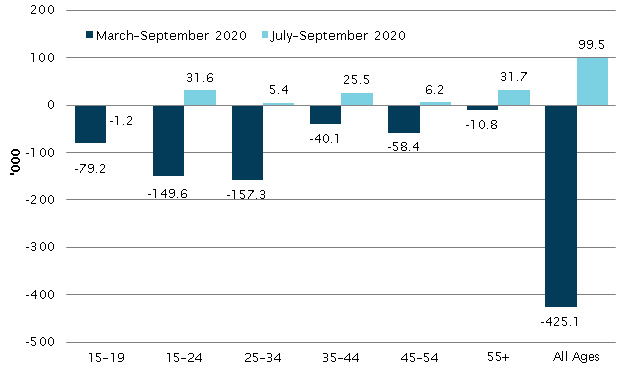
Source: ABS, Labour Force,
cat. no. 6202.0, Table 22, seasonally adjusted
Unemployment
by age
People aged 25 to 34 years recorded the biggest increase in
unemployment between March and September 2020 (up 78,500 or 50.9%) with only a
very small decline (of 2,600) in the most recent two months (see chart 2).
Young people aged 15 to 24 years experienced the next
biggest increase in unemployment (up 47,600 or 18.7%) in the six months to
September 2020 but recorded a substantial fall in unemployment in the past two
months (down 41,300 or 12.0%).
Total unemployment in Australia reached just over 1 million for
the first time in July 2020, but has since fallen to 937,400 in September.[11]
Total unemployment is up by 221,600 (or 31.0%) since March.
Chart 2: change
in unemployment by age, March to September 2020
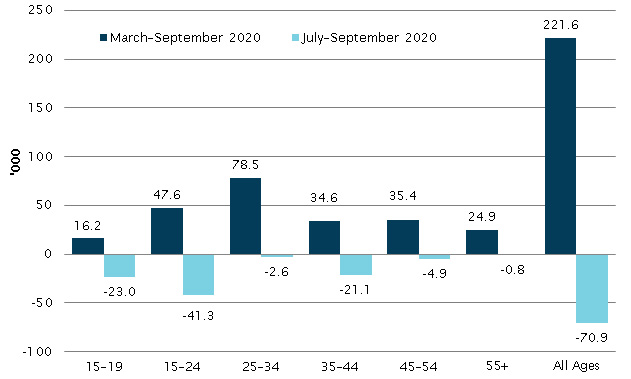
Source: ABS, Labour Force,
cat. no. 6202.0, Table 22, seasonally adjusted
In the period between March and September 2020 people aged
15 to 24 years experienced the largest increase in their unemployment rate (up
2.9 percentage points to 14.5%) followed by those aged 25 to 34 years (up 2.6
percentage points to 7.3%) (see chart 3).
Chart 3: change
in unemployment rates by age, March to September 2020
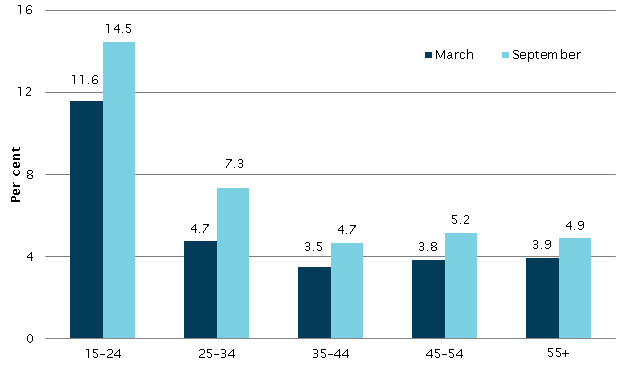
Source: ABS, Labour Force,
cat. no. 6202.0, Table 22, seasonally adjusted
Labour market impacts by gender
Chart 4 shows men recorded a larger fall in employment than
women in the six months to September 2020, a larger increase in the number of
unemployed and a much bigger increase in underemployment.[12]
In the two months to September, women experienced a larger rebound in
employment than men, a larger fall in unemployment than men, and a small
contraction in underemployment compared with an increase for men.
Chart 4: change in key labour
market indicators by gender, March to September 2020
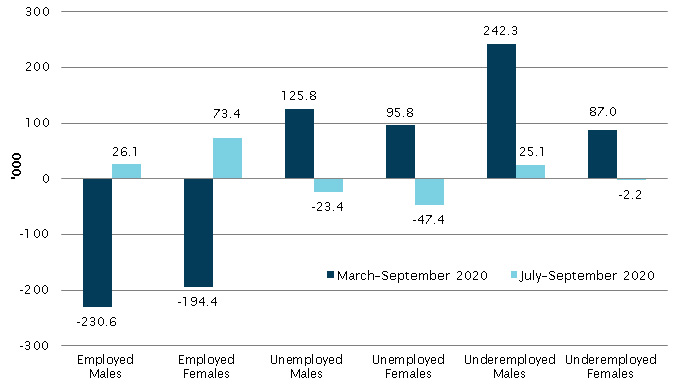
Source: ABS, Labour Force,
cat. no. 6202.0, Table 22, seasonally adjusted
Employment for men fell by 230,600 (or 3.4%) between March
and September 2020 while employment for women fell by 194,400 (or 3.2%).
Unemployment for men increased by 125,800 (or 32.8%) which compares with a
95,800 increase for women (or 28.8%). Men recorded a much bigger increase in
underemployment—up 242,300 (or 46.7%)—compared with an increase of
87,000 (or 12.6%) for women.
A larger drop in full-time employment compared with
part-time employment was recorded nationally between March and September 2020
(down 331,100 (or 3.7%) and 93,900 (or 2.3%) respectively). Total employment
across the economy fell by 425,100 or 3.3%. [13]Men
and women were affected differently with men experiencing a slightly larger percentage
fall in full-time employment (a fall of 4.0% compared with a fall of 3.4%) than
women and women recording a larger fall in part-time employment than men (a
fall of 2.9% compared with a fall of 0.9%) (see table 7).
Table 7: change in full-time and
part-time employment by gender, March to September 2020
| |
Full-time |
Part-time |
Total |
| Males |
|
|
|
| March 2020 (‘000) |
5 531.7 |
1 315.8 |
6 847.5 |
| September 2020 (‘000) |
5 312.6 |
1 304.3 |
6 616.8 |
| Change – March to September 2020 |
|
|
|
| ‘000 |
-219.1 |
-11.5 |
-230.6 |
| % |
-4.0 |
-0.9 |
-3.4 |
| Females |
|
|
|
| March 2020 (‘000) |
3 339.7 |
2 809.8 |
6 149.5 |
| September 2020 (‘000) |
3 227.7 |
2 727.4 |
5 955.1 |
| Change – March to September 2020 |
|
|
|
| ‘000 |
-112.0 |
-82.4 |
-194.4 |
| % |
-3.4 |
-2.9 |
-3.2 |
| Total |
|
|
|
| March 2020 (‘000) |
8 871.4 |
4 125.6 |
12 997.0 |
| September 2020 (‘000) |
8 540.3 |
4 031.7 |
12 571.9 |
| Change – March to September 2020 |
|
|
|
| ‘000 |
-331.1 |
-93.9 |
-425.1 |
| % |
-3.7 |
-2.3 |
-3.3 |
Source: ABS, Labour Force,
cat no 62020, Table 1.
Hours worked
by gender
Chart 5 plots the number of hours worked by males and
females from March to September 2020 including the big drop hours in worked in
April, a smaller fall in May and a slow recovery since.
Chart 5: hours worked by gender, March
to September 2020
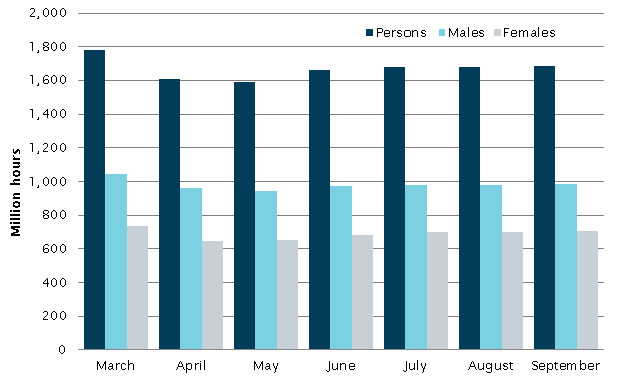
Source: ABS, Labour Force,
cat. no. 6202.0, Table 22, seasonally adjusted
Chart 6 shows women experienced a more substantial fall in
April 2020 (down 12.0% for women and 7.7% for men) but have experienced a
slightly higher monthly percentage increase in hours worked than men in all
months since apart from September 2020.
Chart 6: percentage change in
monthly hours worked by gender, March to September 2020
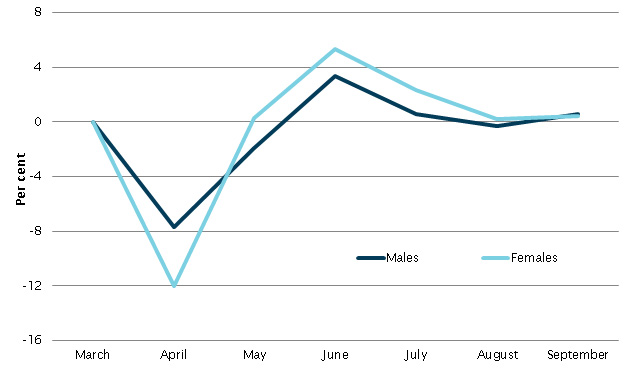
Source: ABS, Labour Force,
cat. no. 6202.0, Table 22, seasonally adjusted
Average weekly hours worked by men has fallen from 38.0
hours in March 2020 to 37.1 hours in September (a fall of 2.4%) while average
weekly hours worked by women has fallen from 30.0 hours per week to 29.6 hours
(a fall of 1.2%).[14]
There were 903,500 people who worked fewer than their usual
hours for economic reasons [15]in
September 2020, which compares with 1,781,500 in April—a fall of 878,000
or almost one half.[16]
There have been substantial monthly swings in the numbers of
people working zero hours in the six months to September 2020—increasing
by 690,400 in April following the imposition of trading restrictions in March
(to 766,900). This was followed by a fall in the number of people working zero
hours of just under 400,000 in May as some people who were stood down returned
to work. The number of people working zero hours was last recorded at 198,700
in September which compares with 76,500 in March before the restrictions were
introduced.[17]
Since July, in all states and territories except Victoria,
the number of people working zero hours for economic reasons has remained
relatively steady or decreased slightly. In Victoria, the number of people
working zero hours for economic reasons almost doubled between July and August.
Victoria accounted for almost 60% of people working zero hours for economic
reasons in September 2020.[18]
Change in
employment by state and territory
Victoria has been by far the hardest hit jurisdiction in
terms of loss of employment (at 218,800) between March and September 2020,
followed by New South Wales (down 95,000).
Chart 7: change
in employment by state/territory, March to September 2020
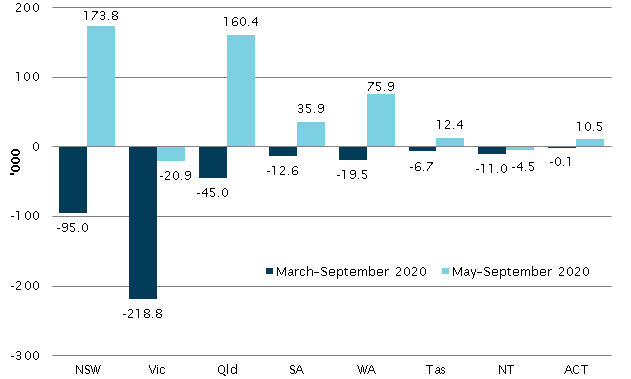
Source: ABS, Labour Force,
cat. no. 6202.0, Table 22, seasonally adjusted for the states and original data
for the two territories
National employment fell to just over 12.1 million in May
2020. Since May there has been a strong recovery in employment in New South
Wales (up 173,800), Queensland (up 160,400) and Western Australia (up 75,900).
In contrast employment fell in Victoria (down 20,900) and the Northern
Territory (down 4,500). The decline in employment in Victoria is directly
related to strict lockdown procedures enforced to counter a second wave of
COVID-19 infections. The falling employment outcome for the Northern Territory
is likely to be related to a decline in domestic and international tourism
activity as well as a combination of other factors. International visitor
numbers were down 21% in the Northern Territory in 2019-20 compared with the
previous financial year.[19]
Domestic visitors to the Northern Territory were down 18% in 2019-20 compared
with the previous financial year and domestic tourist spending was down 26%.[20]
Change in
unemployment rates by state and territory
Chart 8 shows the unemployment rate for each state and
territory for March, July and September 2020. Between July and September the
unemployment rate in New South Wales and Victoria has remained relatively
stable. In the same time period the unemployment rate fell substantially in
Queensland, South Australia, Western Australia, the Northern Territory and the
ACT, but increased in Tasmania. Movements in the unemployment rate for the
territories and smaller states (such as Tasmania) are much more volatile from
month to month compared with larger jurisdictions. However, it is notable that
the participation rate in Tasmania has been rising steadily between May and
September (up from 57.4% to 61.1%) which has contributed to a higher
unemployment rate in the state as entrants into the labour market have found it
harder to find work in the current economic environment.
Chart 8: unemployment rate by
state/territory, March to September 2020
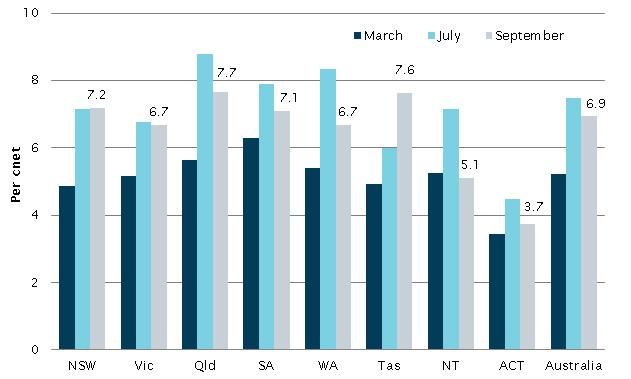
Source: ABS, Labour Force,
cat. no. 6202.0, Table 22, seasonally adjusted for the states and original data
for the two territories
Change in
labour force participation by state and territory
Labour force participation is another indicator that can
shed light on the health of the economy. An increasing participation rate is a
sign of confidence within job seekers that they can enter the labour market and
find work. The labour force participation rate in Australia fell to 62.7% in
May 2020 which compares with 65.9% in March. Since May the labour force participation
rate has increased nationally to 64.8% in September.
Chart 9 shows the extent of changes in labour force
participation rates in the state and territories since May. All states and
territories apart from Victoria and the Northern Territory have been
characterised by increasing participation rates.
Chart 9: change in participation
rates for states and territories, May to September 2020
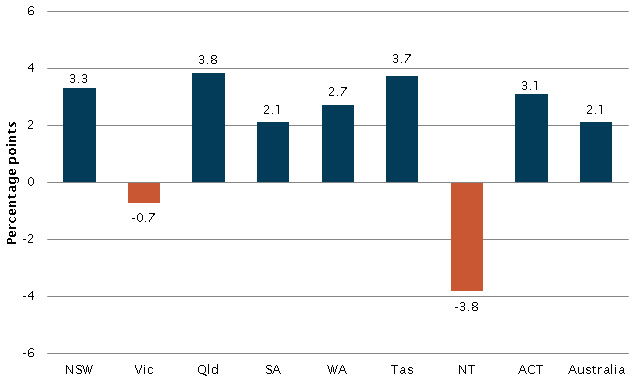
Source: ABS, Labour Force,
cat. no. 6202.0, Table 22, seasonally adjusted for the states and original data
for the two territories
Impact on
industries
Table 8 shows the impacts of restrictions imposed to limit
the spread of the COVID-19 pandemic on employment by industry in Australia.
Note that the data available has a starting month of February—prior to
restrictions being imposed—and the latest data available is for August
2020.
The industries most affected by employment loss were
Accommodation and food services (down 18.2%), Arts and recreation services
(down 17.9%), Other services (down 11.3%), Administrative and support services
(down 11.1%) and Information, media and telecommunications and Transport,
postal and warehousing (both down 8.2%).
In contrast, some industries are faring much better and are
even expanding. For example, employment in Electricity, gas, water and waste
services increased by 15,100 (or 11.1%) between February and August, while
employment increased in Agriculture, forestry and fishing by 22,400 (or
6.6%)—driven in part by improvement in climatic conditions.
Other industries experiencing employment growth included Wholesale
trade (up 4.2%), Public administration and safety (up 3.9%), Financial and
insurance services (up 1.6%), Education and training (up 1.3%) and Mining and Rental,
hiring and real estate services (both up 0.7%).
Table 8: change in employment by
industry, February to August 2020
| Industry |
February
2020 |
August 2020 |
Change —
February to
August 2020 |
| ‘000 |
‘000 |
‘000 |
% |
| Agriculture, forestry & fishing |
337.5 |
359.9 |
22.4 |
6.6 |
| Mining |
238.9 |
240.5 |
1.6 |
0.7 |
| Manufacturing |
909.6 |
843.9 |
-65.7 |
-7.2 |
| Electricity, gas, water & waste services |
136.2 |
151.3 |
15.1 |
11.1 |
| Construction |
1 182.4 |
1 152.4 |
-30.0 |
-2.5 |
| Wholesale trade |
386.0 |
402.1 |
16.1 |
4.2 |
| Retail trade |
1 261.1 |
1 196.7 |
-64.4 |
-5.1 |
| Accommodation & food services |
929.8 |
760.7 |
-169.1 |
-18.2 |
| Transport, postal & warehousing |
667.1 |
612.5 |
-54.6 |
-8.2 |
| Information media & telecommunications |
211.7 |
194.2 |
-17.4 |
-8.2 |
| Financial & insurance services |
474.8 |
482.4 |
7.6 |
1.6 |
| Rental, hiring & real estate services |
213.9 |
215.4 |
1.5 |
0.7 |
| Professional, scientific & technical services |
1 172.7 |
1 118.5 |
-54.2 |
-4.6 |
| Administrative & support services |
450.2 |
400.2 |
-50.0 |
-11.1 |
| Public administration & safety |
829.6 |
862.0 |
32.3 |
3.9 |
| Education & training |
1 097.6 |
1 111.7 |
14.1 |
1.3 |
| Health care & social assistance |
1 800.1 |
1 772.4 |
-27.7 |
-1.5 |
| Arts & recreation services |
251.9 |
206.7 |
-45.2 |
-17.9 |
| Other services |
493.2 |
437.6 |
-55.6 |
-11.3 |
| All industries |
13 044.3 |
12 521.1 |
-523.2 |
-4.0 |
Source: ABS, Labour
Force, cat. no. 6291.0.55.003, Table 04 (original data)
Employment loss for women working in Accommodation and food
services was slightly higher than employment loss for men. Employment in the
sector for women fell by 94,400 (or 18.4%) between February and August 2020
which compares with loss of employment of 74,700 (or 18.0%) for men.
For men employment loss was highest in Accommodation and
food services, followed by Transport, postal and warehousing (down 70,400 or
13.2%), Construction (down 50,600 or 4.9%), and Manufacturing (down 48,400 or
7.5%). For women employment loss was greatest in Accommodation and food
services, followed by Retail trade (down 56,900 or 8.0%); Professional,
scientific and technical services (down 53,600 or 10.3%); and Administrative
and support services (down 36,500 or 16.0%). Men recorded much smaller falls in
employment than women in Retail trade (down 7,500 or 1.4%) and Professional,
scientific and technical services (down 500 or 0.1%)[21]
Impact on
casual and permanent employees and owner managers
The impact of imposing trading restrictions to restrict the
transmission of COVID-19 has had a disproportionate impact on casual employees
(or employees without paid leave entitlements). Casual employees account for a
large proportion of all employees working in service industries which were
among the most heavily impacted by the restrictions in terms of employment
loss.[22]
The number of casual employees fell by 339,800 (or 12.9%) between
February and August 2020 while the number of permanent employees (or employees
with paid leave entitlements) fell by 125,600 (or 1.5%) (see table 9).
Impacts have been significant for casual employees working both
full-time (down 160,600 or 18.2%) and part-time (down 179,100 or 10.3%). In
contrast, the number of permanent employees working part-time increased by 107,400
(or 6.7%. However, the number of permanent employees working full-time fell by
233,000 or 3.5%.
Total employees (permanent and casual) working full-time
fell by 393,600 (or 5.2%) between February and August while total part-time
employees fell by 71,800 (or 2.1%).
Table 9: change in permanent and
casual employees, February to August 2020
| Form of employment |
Feb-2020 |
Aug-2020 |
Change —
Feb to August 2020 |
| ‘000 |
‘000 |
000 |
% |
| Employees - full-time |
7 532.1 |
7 138.5 |
-393.6 |
-5.2 |
| Employees - part-time |
3 354.4 |
3 282.6 |
-71.8 |
-2.1 |
| Permanent employees - total |
8 259.3 |
81 33.7 |
-125.6 |
-1.5 |
| Permanent employees - full-time |
6 651.5 |
6 418.5 |
-233.0 |
-3.5 |
| Permanent employees - part-time |
1 607.8 |
17 15.2 |
107.4 |
6.7 |
| Casual employees - total |
2 627.2 |
2 287.4 |
-339.8 |
-12.9 |
| Casual employees - full-time |
880.6 |
720.0 |
-160.6 |
-18.2 |
| Casual employees - part-time |
1 746.5 |
1567.4 |
-179.1 |
-10.3 |
| Total employees |
10 886.5 |
10 421.1 |
-465.4 |
-4.3 |
Source: ABS, Labour Force,
cat. no. 6291.0.55.003, Table 13 (original data)
While employees of public and private employers have
experienced a substantial decline in employment between March and August 2020 (down
482,600) there appears to have been little impact on owner managers of
incorporated enterprises (down 10,300), while the number of owner managers of
unincorporated enterprises has grown slightly (up 7,300) (see chart 10).
Owner managers of incorporated enterprises are defined as people
who work in their own incorporated enterprise, that is, a business entity which
is registered as a separate legal entity to its members or owners (may also be
known as a limited liability company). Owner managers of unincorporated
enterprises are people who operate their own unincorporated enterprise or
engage independently in a profession or trade.[23]
Chart 10: change in employees and
owner managers, March to August 2020
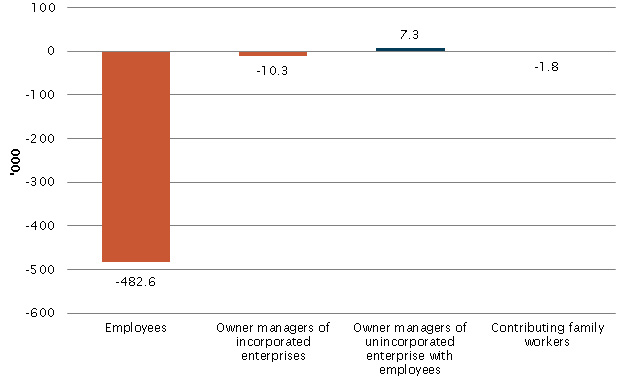
Source: ABS, Labour Force,
cat. no. 6291.0.55.003, Table 08 (original data)
Impact on numbers of people
receiving unemployment benefits
Young people were the most heavily affected in terms of
increases in numbers of people receiving unemployment benefits following the
imposition of trading restrictions in March 2020 to combat the spread of
COVID-19. Between March and August 2020:
- The number of people receiving unemployment benefits that were
aged under 25 years and 25 to 34 years more than doubled (up 102.2% and 122.0%
respectively).
- All age groups experienced significant increases in people
receiving unemployment benefits including those in older age groups.
- Men were affected more than women, with a 90.4% increase in men
receiving benefits to 870,143, compared with a 75.7% increase for women to
754,126.
- The total number of Australians receiving JobSeeker Allowance or
Youth Allowance (Other) increased from 886,213 to 1,624,269 (up 808,056 or 83.3%)
(see table 10).
Table 10: JobSeeker Payment and
Youth Allowance (Other) recipients, March and August 2020
| By Age Group |
Females |
Males |
Total |
| March 2020 |
August 2020 |
Change:
March
to
August |
March 2020 |
August 2020 |
Change:
March
to
August |
March 2020 |
August 2020 |
Change:
March
to
August |
| Under 25 |
72 919 |
147 580 |
102.4% |
89 047 |
179 919 |
102.0% |
161 966 |
327 499 |
102.2% |
| 25-34 |
63 062 |
146 930 |
133.0% |
103 021 |
221 705 |
115.2% |
166 083 |
368 635 |
122.0% |
| 35-44 |
79 912 |
137 721 |
72.3% |
87 568 |
166 914 |
90.6% |
167 480 |
304 635 |
81.9% |
| 45-54 |
97 971 |
152 860 |
56.0% |
82 462 |
145 866 |
76.9% |
180 433 |
298 726 |
65.6% |
| 55-64 |
103 038 |
151 714 |
47.2% |
84 008 |
139 494 |
66.0% |
187 046 |
291 208 |
55.7% |
| 65 + |
12 363 |
17 321 |
40.1% |
10 842 |
16 245 |
49.8% |
23 205 |
33 566 |
44.6% |
| Total |
429 265 |
754 126 |
75.7% |
456 948 |
870 143 |
90.4% |
886 213 |
1 624 269 |
83.3% |
Source: Department of Social
Security, JobSeeker Payment and Youth Allowance recipients
– monthly profile.
[1]
ABS, Weekly
Payroll Jobs and Wages in Australia, cat. no. 6160.0.55.001, Methodology.
[2]
ABS, Labour
Force, detailed, cat. no. 6291.0.55.001, Table 01.
[3]
Treasury, Economic Response to the
Coronavirus.
[4]
G Gilfillan, COVID-19:
Impacts on casual workers in Australia—a statistical snapshot, May
2020.
[5]
Deloitte Access Economics, Business Outlook, September
2020, p 130.
[6]
G Gilfillan, Characteristics
and use of casual employees in Australia, January 2018.
[7]
ABS, Labour
Force, Australia, Detailed, cat. no. 6291.0.55.001, Table 8.
[8]
ABS, Weekly
Payroll Jobs and Wages in Australia, cat. no. 6160.0.55.001, Table 3: Industry
spotlight.
[9]
ABS, Weekly
Payroll Jobs and Wages in Australia, cat. no. 6160.0.55.001.
[10]
ABS, Jobs
in Australia, cat no. 6160.0.
[11]
ABS, Labour
Force, cat. no. 6202.0, Table 1.
[12]
People can be underemployed if they are part-time workers seeking
more hours and are available to start, or full-time workers who worked less
hours due to economic reasons such as being stood down.
[13]
ABS, Labour
Force, cat. no. 6202.0, Table 1.
[14]
ABS, Labour
Force, cat. no. 6202.0, Table 19 (Parliamentary Library calculations).
[15]
Economic reasons include a reduction in economic activity or
seasonal highs and lows.
[16]
ABS, Labour
Force, cat. no. 6202.0, Insights into hours worked, September 2020.
[17]
Ibid.
[18]
Ibid.
[19]
Tourism Research Australia, International
Visitor Survey.
[20]
Tourism Research Australia, National
Visitor Survey.
[21]
ABS, Labour
Force, cat. no. 6291.0.55.003, Datacube EQ06.
[22]
G Gilfillan, Characteristics
and use of casual employees in Australia, January 2018.
[23]
ABS, Characteristics
of Employment, cat. no. 6333.0, Glossary.
For copyright reasons some linked items are only available to members of Parliament.
© Commonwealth of Australia
Creative Commons
In essence, you are free to copy and communicate this work in its current form for all non-commercial purposes, as long as you attribute the work to the author and abide by the other licence terms. The work cannot be adapted or modified in any way. Content from this publication should be attributed in the following way: Author(s), Title of publication, Series Name and No, Publisher, Date.
To the extent that copyright subsists in third party quotes it remains with the original owner and permission may be required to reuse the material.
Inquiries regarding the licence and any use of the publication are welcome to webmanager@aph.gov.au.
This work has been prepared to support the work of the Australian Parliament using information available at the time of production. The views expressed do not reflect an official position of the Parliamentary Library, nor do they constitute professional legal opinion.
Any concerns or complaints should be directed to the Parliamentary Librarian. Parliamentary Library staff are available to discuss the contents of publications with Senators and Members and their staff. To access this service, clients may contact the author or the Library‘s Central Enquiry Point for referral.